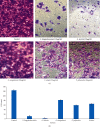Activities of Some Medicinal Plants on the Proliferation and Invasion of Brain Tumor Cell Lines
- PMID: 32908971
- PMCID: PMC7474344
- DOI: 10.1155/2020/3626879
Activities of Some Medicinal Plants on the Proliferation and Invasion of Brain Tumor Cell Lines
Abstract
Cancer is a debilitating disease that is on the increase in both developed and developing countries. Anticancer drugs are often expensive, have narrow spectrum of activities, and are associated with toxicities and side effects such as myelosuppression, immunosuppression, gastrointestinal disturbance, alopecia, skin toxicity, and hepatotoxicity. Plants have been the major source of anticancer drugs both in orthodox and traditional medicine. Many of the plants claimed by the traditional medicine practitioners (TMPs) to be effective in the treatment of cancer are yet to be evaluated scientifically. In this work, five medicinal plants used by TMPs in Borno State, Nigeria, were tested against two brain tumor cell lines. Ethanol extracts of Securidaca longepedunculata, Andira inermis subsp. rooseveltii, Annona senegalensis, Carissa edulis, and Parinari polyandra were used. U87 and U231 brain tumor cell lines were used for proliferation assay, U251 cell line was used for the invasion assay in collagen V coated inserts, and U87 cell line was used for the western blot detection of cleaved Poly-ADP-Ribose-Polymerase (PARP). The result revealed that all tested extracts significantly (p < 0.05) inhibited the proliferation of U87 and U231 cell lines with the respective IC50 values ranging between 8 and 20 μg/ml for S. longepedunculata and 100 and 90 μg/ml for P. polyandra. The five extracts significantly (p < 0.05) inhibited the invasion of U251 cell line at the concentration of 10 μg/ml (S. longepedunculata), 20 μg/ml (A. inermis), 50 μg/ml (A. senegalensis), 50 μg/ml (C. edulis), and 50 μg/ml (P. polyandra). Securidaca longepedunculata extract induced the cleavage of PARP. It was concluded that these medicinal plants have antiproliferative and anti-invasive activities and possess good prospects as source of anticancer agents especially S. longepedunculata which induced apoptosis in U87 cell line.
Copyright © 2020 Saidu I. Ngulde et al.
Conflict of interest statement
The authors declare no conflicts of interest.
Figures




Similar articles
-
Ethanol Extract of Securidaca longipedunculata Induces Apoptosis in Brain Tumor (U87) Cells.Biomed Res Int. 2019 Feb 26;2019:9826590. doi: 10.1155/2019/9826590. eCollection 2019. Biomed Res Int. 2019. PMID: 30931334 Free PMC article.
-
Antimycobacterial evaluation and preliminary phytochemical investigation of selected medicinal plants traditionally used in Mozambique.J Ethnopharmacol. 2011 Sep 1;137(1):114-20. doi: 10.1016/j.jep.2011.04.062. Epub 2011 May 5. J Ethnopharmacol. 2011. PMID: 21571059
-
Cytotoxicity of methanol extracts of 10 Cameroonian medicinal plants towards multi-factorial drug-resistant cancer cell lines.BMC Complement Altern Med. 2016 Aug 2;16:267. doi: 10.1186/s12906-016-1253-3. BMC Complement Altern Med. 2016. PMID: 27484842 Free PMC article.
-
Proliferative effects of five traditional Nigerian medicinal plant extracts on human breast and bone cancer cell lines.J Ethnopharmacol. 2011 Sep 2;137(2):1003-10. doi: 10.1016/j.jep.2011.07.023. Epub 2011 Jul 18. J Ethnopharmacol. 2011. PMID: 21782919
-
Antibacterial and antibiofilm activities of Mayan medicinal plants against Methicillin-susceptible and -resistant strains of Staphylococcus aureus.J Ethnopharmacol. 2021 Oct 28;279:114369. doi: 10.1016/j.jep.2021.114369. Epub 2021 Jun 26. J Ethnopharmacol. 2021. PMID: 34186100
Cited by
-
Increasing the effect of annonacin using nanodiamonds to inhibit breast cancer cells growth in rats (Rattus norvegicus)-Induced breast cancer.Heliyon. 2022 Nov 5;8(11):e11418. doi: 10.1016/j.heliyon.2022.e11418. eCollection 2022 Nov. Heliyon. 2022. PMID: 36387488 Free PMC article.
-
Polygonatum sibiricum Saponin Prevents Immune Dysfunction and Strengthens Intestinal Mucosal Barrier Function in Cyclophosphamide-Induced Immunosuppressed BALB/c Mice.Foods. 2024 Mar 19;13(6):934. doi: 10.3390/foods13060934. Foods. 2024. PMID: 38540924 Free PMC article.
-
Sonicated Extract from the Aril of Momordica Cochinchinensis Inhibits Cell Proliferation and Migration in Aggressive Prostate Cancer Cells.J Toxicol. 2022 Dec 27;2022:1149856. doi: 10.1155/2022/1149856. eCollection 2022. J Toxicol. 2022. PMID: 36605288 Free PMC article.
-
Immunomodulatory Effect of Ginsenoside Rb2 Against Cyclophosphamide-Induced Immunosuppression in Mice.Front Pharmacol. 2022 Jun 24;13:927087. doi: 10.3389/fphar.2022.927087. eCollection 2022. Front Pharmacol. 2022. PMID: 35814238 Free PMC article.
-
Evaluation of the antiproliferative, cytotoxic and phytochemical properties of Zimbabwean medicinal plants used in cancer treatment.BMC Complement Med Ther. 2025 Apr 24;25(1):156. doi: 10.1186/s12906-025-04883-1. BMC Complement Med Ther. 2025. PMID: 40275320 Free PMC article.
References
-
- Parkin D. M., Ferlay J., Cherif M., et al. Cancer in Africa Epidemiology and Prevention. Lyon, France: IARC Press; 2003.
-
- World Health Organization. The impact of cancer-Nigeria. 2008. http://www.who.int/infobase/report.aspx Accessed on 17/03/12.
-
- Omolara K. A. Feasible cancer control strategies for Nigeria: mini-review. American Journal of Tropical Medicine and Public Health. 2011;1:1–10.
-
- World Health Organization. General Guidelines for Methodologies on Research and Evaluation of Traditional Medicine. Geneva, Switzerland: World Health Organization; 2000.
-
- Kingston D. G. I. Taxols and its analogs. In: Cragg G. M., Kingston D. G. I., Newman D. J., editors. Anticancer Agents from Natural Products. 2nd. Boca Raton, FL, USA: Brunner-Routledge Psychology Press, Taylor and Francis Group; 2012. p. p. 123.
Grants and funding
LinkOut - more resources
Full Text Sources
